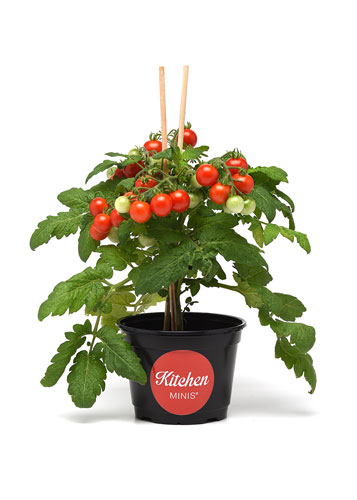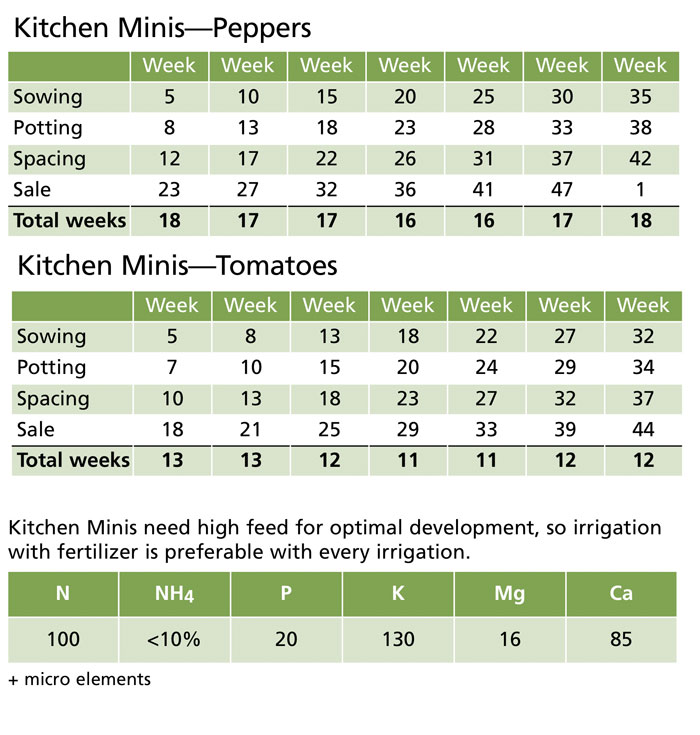10/1/2022
Kitchen Minis Tabletop Vegetables: A Growing Guide
Carsten Leth

Drive through any neighborhood—urban or suburban—and you’re sure to find a backyard, patio or balcony with at least one veggie plant thriving. Consumers are still showing high interest in growing their own vegetables and herbs at home. Since this trend has been around for decades, greenhouse growers have a comfort level with producing retail-ready vegetable plants for home gardeners.
Now the new consumer movement is the small-space—or even NO SPACE—gardening. This new edible potted vegetable trend can be seen with the launch of PanAmerican Seed’s Kitchen Minis tabletop tomatoes and peppers. Available in fruiting pot sizes as small as 4 in., Kitchen Minis represent a new opportunity to supply vegetable plants most months of the year. No garden? No problem!
But what’s the secret to producing top-quality Kitchen Minis vegetables that consumers will be most pleased to buy, eat and repeat? Follow these charts and guidelines from the experts and soon you’ll supply the market with these unique and trendy edibles.
Production scheduling
First and foremost, production time depends on the light and temperature conditions under which plants are produced. The weeks mentioned in these pepper and tomato production schedule charts are for northern climates and can be used as a guideline for Kitchen Minis varieties. In warmer regions with high light levels, production time will usually be one to two weeks faster.
We recommend using plugs grown in a 264/288-cell tray or similar. Most growing medias can be used, but as plants need to be grown dry, good drainage is important. Substrates mixed with coco fiber work well. It’s important to use substrate with a starter fertilizer.
Potting & spacing
While plants need to be grown dry, plugs should not be dry when being potted. Start out moderate-moist to get roots established (moisture level 4 to 2). When roots become visible, begin growing dry. To ensure the best growth habit of these smaller, fruiting vegetables, plant the young plants as deeply as possible, preferably with the cotyledons right at the level of the media.
Plants should then be spaced three to four weeks after potting.
• 4 in. (13 cm) 20 to 22 pl./10ft2/m2
• 6 in. (14 cm) 16 to 18 pl./10ft2/m2
From the spacing to flowering stage, keep the plants very dry (moisture level 3 to 1). If plants are grown dry as recommended, it will have a positive impact on fruit set, as it promotes better flowering. How dry? The weight of a 4-in. (13-cm) pot can be as low as 10 oz. (300 g) before irrigated.

Nutrition & fertigation
It’s highly recommended to check EC and pH levels in the pots weekly. Recording the results is a good way to ensure the crops stay on track. Use of soil analyzers, for example two weeks after spacing, will not only show pH and EC levels, but also balance between elements.
The EC/pH level in the pot for both peppers and tomatoes:
• EC 1 to 1.5 (1:2 ratio)
• pH 5.3 to 5.8
We recommend NOT to use any PGRs during production of edible products. The Kitchen Minis varieties are naturally compact and growth/fruiting is controlled with moisture levels instead of external PGR use.
Correct watering is essential to growing Kitchen Minis successfully. Best results are achieved if irrigation is combined with light watering from the top with sprinklers or hose/nozzle. This will cool down the plants, the soil will remain dry and stretching is avoided. Even after being very dry, plants recover easily. Complete irrigation is still needed to ensure supply of fertilizer.
Climate & plant support
Recommended growing temperature is 65 to 80F (18 to 27C), with best results if temperature is kept between 68 to 77F (20 to 25C). Kitchen Minis vegetables are “heat-lovers” and tolerate high temperatures and high light intensity. Too low will delay production time and cause problems setting fruit.
Due to the weight of the fruits and to help Kitchen Minis plants during transport, we recommend using split bamboo and clips as support. The ultimate production goal is to ship healthy Kitchen Minis plants to retail with fruit already established and possibly ripening. This gives the best presentation at retail and helps the consumer buy, eat, repeat.
For more information, downloadable Kitchen Minis culture guides, as well as retail sales tools, can be found online at panamseed.com/kitchenminis. GT
Carsten Leth is Potted Plant Technical Support for PanAmerican Seed.